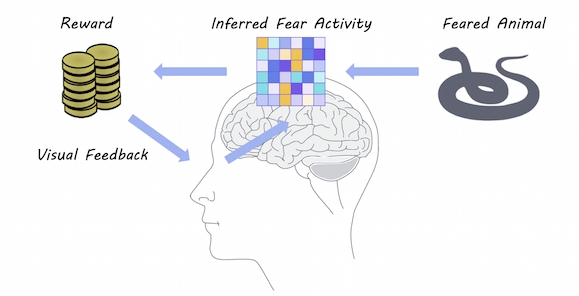An Unconscious Intervention for Fear
What's the science?
One typical treatment for anxiety disorders involves exposure to the feared stimulus (i.e. exposure therapy). Going through exposure therapy can be uncomfortable, so approximately 15% of participants drop out. Currently, there are no effective treatments to avoid this discomfort. This week in PNAS, Taschereau-Dumouchel and colleagues tested a new method to reproduce fear representations in the unconscious (unaware) brain in order to reduce fear.
How did they do it?
A group of individuals were shown images of feared animals during fMRI scans and brain activity patterns were decoded (using machine learning). These fear-related brain activity patterns were used to infer fear-related brain activity in the main study participants. The main group of participants underwent 5 days of neural reinforcement sessions. The goal was to use visual feedback to reinforce fear-related brain activity patterns, without actual exposure to the feared animal stimulus. During these sessions, a disc was shown on a screen to participants; the disk grew bigger in real time when participants’ brain activity better matched the brain activity pattern associated with a feared animal. Participants were awarded money in an amount proportional to the size of the disc. Both participants and researchers were blinded (i.e. did not know what the size of the disk represented). They then tested how well the neural reinforcement worked using well-established physiological fear responses: skin conductance and amygdala (a brain region processing fear) activation.
What did they find?
Participants were able to learn to activate a particular brain activity pattern corresponding to a feared animal with consistency. They found that two physiological fear responses - both amygdala activation and skin conductance - were reduced after the neural reinforcement sessions but remained unchanged for the placebo condition (i.e. participant did not receive intervention). These responses were just as effective as responses seen for traditional exposure therapy. The participants remained unaware of whether their brain activity patterns corresponded to fear or not, meaning they had no conscious awareness of the treatment. The brain areas important in predicting the neural reinforcement effects were the fusiform, inferior temporal and lingual cortices.
What's the impact?
This is the first study to show that unconscious neural reinforcement could be used as a treatment for fear. Previously, there were no effective treatments to avoid exposing a patient to uncomfortable stimuli. Unconscious neural reinforcement could be used to help treat disorders such as post-traumatic stress disorder or anxiety and prevent dropout.
Reach out to study authors Dr. Vincent Taschereau-Dumouchel and Hakwan Lau on Twitter: @Vincent_T_D and @hakwanlau
V. Taschereau-Dumouchel et al., Towards an unconscious neural reinforcement intervention for common fears. PNAS (2018). Access the original scientific publication here.


